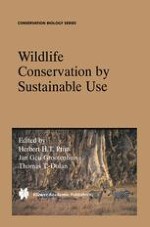2000 | OriginalPaper | Buchkapitel
The Lewa Wildlife Conservancy in Kenya: A Case Study
verfasst von : Peter Szapary
Erschienen in: Wildlife Conservation by Sustainable Use
Verlag: Springer Netherlands
Enthalten in: Professional Book Archive
Aktivieren Sie unsere intelligente Suche, um passende Fachinhalte oder Patente zu finden.
Wählen Sie Textabschnitte aus um mit Künstlicher Intelligenz passenden Patente zu finden. powered by
Markieren Sie Textabschnitte, um KI-gestützt weitere passende Inhalte zu finden. powered by
This case study is an analysis of the financial viability of wildlife conservation at the Lewa Wildlife Conservancy (LWC) in Kenya. In the last decade the form of land use was changed from cattle ranching to wildlife conservation. In 1994 the entire conservation area was fenced. Currently the LWC is strongly dependent on donor contributions to sustain the on-going programmes, in particular the protection of both species of rhinoceros and Grevy’s zebra. In 1996, 29% of the yearly running expenses were financed by the profit centres developed on the Conservancy and 71% were covered by donations. The main source of income was tourism, followed by wildlife sales (cropping) and farming.Due to the high cost of the endangered species programme, the current concept of wildlife conservation is not financially viable, nor is cattle ranching. The Conservancy’s tourism policy does not enable the costs of protection of endangered species to be covered. Potential trophy hunting would reduce the deficit but cannot compensate for the high costs of the sustained programmes.This case study demonstrates that financial independence will be very difficult to achieve. A drastic cost reduction or termination of the endangered species programme, together with a change in the current tourism policy, needs to be considered.On the other hand the contribution of the LWC to national and international conservation, protection of endangered species and the world’s biodiversity needs to be recognised. The LWC with its professional security organisation also plays an important role in the security of the area where it is located and for which it has not been financially supported.
